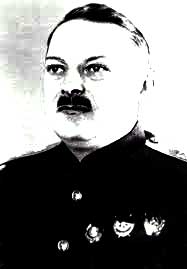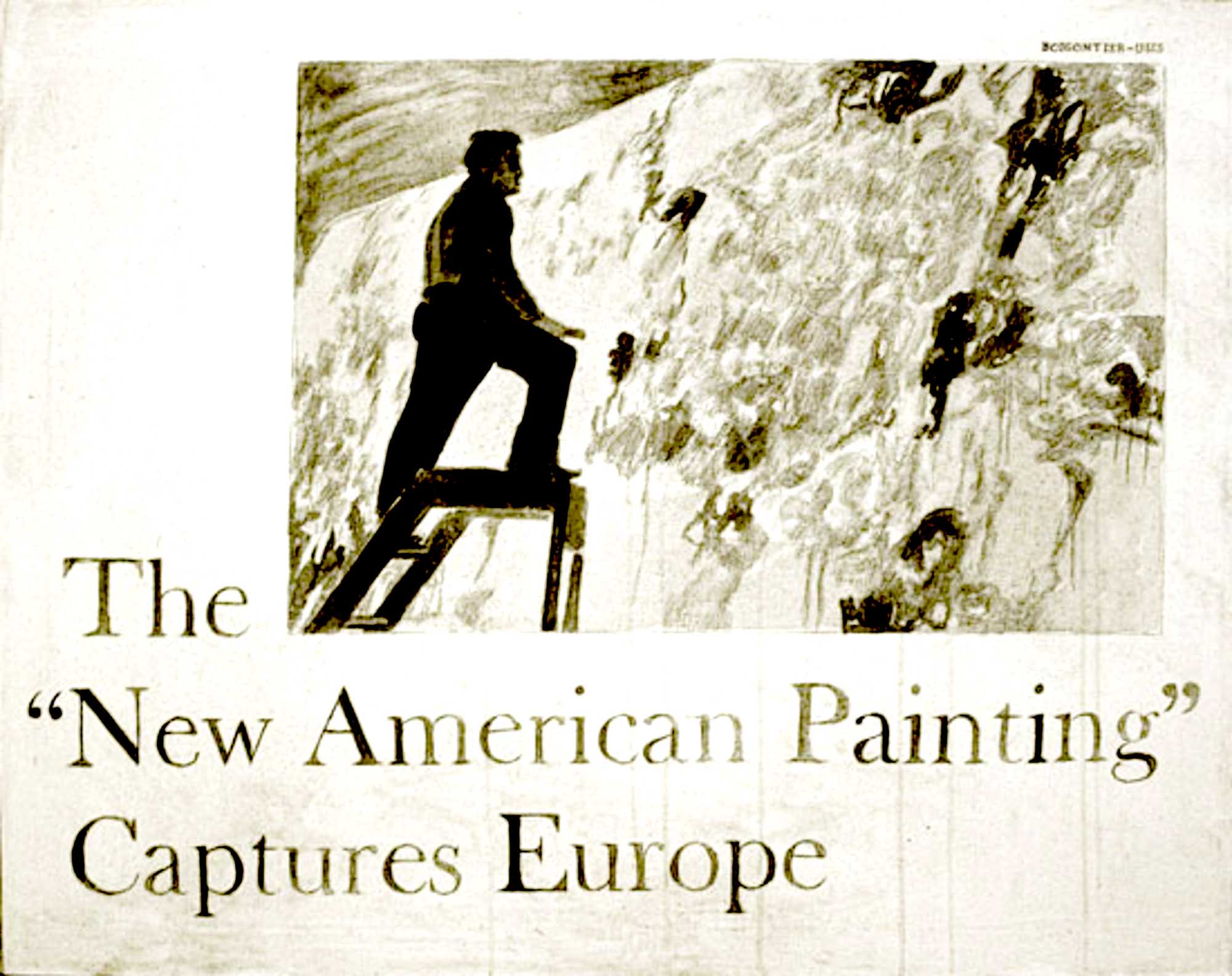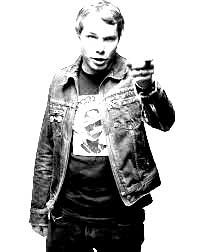
In 1939 Jackson Pollock was a very troubled artist without an audience. He had been toiling away trying to catch up with geniuses like Picasso, but mostly getting nowhere. He had tried to join the army during world war two but was deemed a section eight (mental health) and could therefore, not serve. He felt helpless, depressed and detached. Angry, drunk, and driven he folded into himself and his paintings which he could not sell. Luckily in the spring of 1943 he met a very gifted artist named Lee Krasner. Four years his senior and a better artist, she helped Jackson refine his craft and offered to share her life and the contacts she had accumulated in the art world with him. The support from Krasner allowed Jackson to carry on and continue creating. The stability Lee offered allowed Jackson to try new things and solidify himself as an artist. Somewhere around that same year Lee introduced Jackson to an aristocrat, pseudo intellectual, named Peggy Guggenheim. Peggy had inherited her wealth after her father had died on the Titanic. She used this wealth to indulge herself by living and traveling around Europe until the war forced her back home. Peggy was a remarkably intelligent person and, for the standard of the time an unusually free woman. Lee respected Krasners opinion and took an interest in Jacksons paintings. In 1943 she commissioned Pollock to paint a very large mural for her estate. The work he created is now considered one of the greatest works of art ever made (Jackson after weeks of writers block, conceived and executed the painting in one night). During her purgatory in New York Guggenheim ran a Manhattan art studio, and gave a voice to many an artist who would never have been given a chance to show their work in public. As much as Peggy loved the work of her American artists, she resented the forces that forced her to abandon the Dadaists, and other schools of art that she had championed overseas. Guggenheim unlike most of her American trust fund friends understood the very real threat Fascism and Stalinism represented to the free world. It was her firsthand experience that the CIA used to approach her and make her an intelligence asset to help the nation of her birth fight a cultural war against Stalin and his authoritarian mob.

At the end of the World War II the Soviet 1945 Central committee secretary Andrei Zhdanov introduced the Zhdanov doctrine stating that Soviet artists, writers and intelligentsia in general had to conform to the party line in their creative works. Under this policy, artists who failed to comply with the government's wishes risked persecution and a slow death in Siberian death camps. This persecution wasn't just confined to visual artists. Many writers, scientists, musicians and free thinkers were imprisoned and killed by central planning. It was under the Spector of this environment that Peggy Guggenheim was approached by the CIA and rightly became involved in one of the longest running intelligence campaigns of the cold war.

The program Peggy joined was called "long leash" its principle goal was to show the world that American intellectuals unlike their Soviet counterparts were free to express themselves where ever and how ever they wanted. Peggy Guggenheim was not only willing but uniquely positioned for her role. During her time in Europe she had run a popular advent Gard gallery in London. This gallery showed art by artists who at the time were considered the fringe but, eventually went on to be influential. She showed, financed and purchased art from such notables as Antoine Pevsner ,Henry Moore, Henri Laurens, Alexander Calder, Max Ernst and Pablo Picasso (Pablo oddly, eventually became the wealthiest Communist alive who wasn't Stalin). Her gallery was very popular but in the end she was in the hole financially. With German bombs raining down on Europe she relocated to New York. The CIA's offer fit perfectly with her plans for her new gallery. Long Leash not only offered her a way to fight against the powers that forced her return to America, but also funded her return to the European art world. Her taste in art also played into the motives of Long Leash. Something she would never be filled in on. Abstract expressionism despite its European roots was, by the 40's an almost entirely North American concept. Non Americans viewed the members of this school as cowboys daringly riding their way into unknown territory. Most members of the New York school had roots in the Midwest and were hard drinking, fighting, rebels who made art for kicks. They were also almost entirely socialists philosophically. The CIA knew that if left alone these working class pioneers would eventually become known to the rest of the working class and could subsequently cause a shift in the ideology of the American people. Being the good capitalists that the CIA were they understood that the best way to defuse a movement is to buy one of its members and make them the best sort of patsy, an unwitting one. Peggy wasted no time. With the success of her New York gallery and the funding from CIA shell corporations she planned to fulfill her orders by taking American art overseas and showing firsthand how free Americans were to express themselves. She wasn't the only one either, per CIA operative Tom Braden indicated that there was no shortage of influential people willing to do their part "We would go to somebody in New York who was a well-known rich person and we would say, 'We want to set up a foundation.' We would tell them what we were trying to do and pledge him to secrecy, and they would say, 'Of course I'll do it,' and then you would publish a letterhead and their name would be on it and there would be a foundation. It was really a pretty simple device." This system funneled millions of U.S. tax payer dollars into shadow corporations. The operation was a success and many more overseas shows were held well into the early seventies. The other goal, the one that private operatives were never told is that sending the art overseas would have the effect of automatically making the art seem snooty, pretentious, to a large segment of America's working class. Many of The workers the artists were trying to reach turned their backs based on association alone. This left the working class cogs oiled with ignorance while blissfully turning the gears of the upper class money machine. The end result of these Art expositions had an almost backward effect between Europe and the soviet states than it did back home in the U.S. The CIA had successfully created two different and useful outcomes with the same program. What Americans saw as brow beating was viewed by the Soviet bloc as an example of intellectual freedom!

The cold war and its culture war weren't over though. The soviets continued to expand territory and despite Americas' victory in the space race the culture war raged on. The hard work of Guggenheim and Pollock had done their bit, but success creates acceptance and what was once radical was now common. Long Leash needed to maintain its relevance and to reach those ends it became clear By the mid-sixties the program needed new patsies to replace the aging artists they had used in the post war environment. Someone in the pentagon had a realization that with the Vietnam War over, America would enter an age of escapism and corporate branding would be the new fad. Needing something contemporary to distract the public, Long Leash found the perfect agent in a gifted, yet little known, New York, Corporate, graphic designer named Andy Warhol. Warhol was a second generation Austrian, catholic, artist who had come out of an impoverished childhood in Pittsburgh to be one of the most celebrated advertisers in Manhattan. His ad designs for shoes and other consumer goods had made him wealthier than he had ever thought possible. But he longed to be a gallery artist. Warhol was not only perfect for long leash but, his work seemed tailor made for the end goal of promoting American art. With the blessing of Long Leash Warhol rose to fame. Creating images of American achievement, his works of art reframed capitalist, corporate branding into another commodity, highbrow art. His paintings were of mass produced products, Hollywood movie stars and, everyday American life. Warhol also created a persona that to this day alienates the American working class. A better patsy could not have existed at the time.

Warhol lost prevalence by the mid-eighties and died in 1987 from unexpected medical complications. Worried that the program would fail they turned to one of Warhol's young proteges. Jean-Michel Basquiat was a New York street artist who had done very well for himself. Over the course of a year he had gone from sleeping in a cardboard box in central park to being the darling of the New York art scene. The CIA already had a record on him because Aside from being a painter he was also a vandal. Under the name SAMO (Same old Shit) Jean with help from his friend Al Diaz had been spray painting graffiti all over New York before being "discovered" by the bowery art scene. Jean was clearly a genius with a drive and talent lacking in most humans. Initially he was deemed wrong for the program outwardly. Jean seemed, at best a contrarian and at worst a Black Panther. Jean being part Haitian and Puerto Rican in his ancestry was excluded from the program. With Warhol dead the CIA decided to gamble. Jean-Michel became the first and only known failure of Operation Long Leash. Distraught from his friends recent death he not only wouldn't play ball with long leash he mysteriously destroyed himself with heroin.

In 1988 a young artist named Shepard Fairey had graduated from Idyllwild Arts Academy in sunny San Bernardino California. Idyllwild was a private art school that catered to the children of the upper class. Even In this environment Fairey was a notable fluke who rooted his art in the cultural underworld of skate boarding and punk rock. His works were different from other students and advanced enough to get on the CIAs culture radar. By 1989 Shepard had transferred to the Rhode Island School of Design. Here he was still an artistic misfit by using underground revolutionary iconography, in a way that separated him from his less adventurist Ivy League contemporaries. Eventually one of the students was curious enough to approach the usually isolated Fairey and ask how he made the seemingly sloppy stencil prints that he had churned out to meet his academic requirements. Shepard, unknown to other students was actually a very friendly, approachable person and was more than happy to give a demonstration of his low cost, Warholian method. Much like Warhol Shepard was fascinated by trashy tabloids and pop culture. This led him to use an image from the cover of the World Weekly News of a wrestling great named Andre the Giant as a demonstration image. Shepard was happy enough with the final result to turn the image into stickers. Much like the failed asset Jean-Michel, Shepard was also a vandal. Shepard and his friend began to place the stickers on any surface they came across. CIA groomers from Long Leash knew a good thing when they saw it and began reproducing and distributing the images themselves. Shepherds ego wouldn't let him question the strange popularity of his work and therefor did not come to the realization he was being groomed to be a CIA asset. This fact is best expressed in his own convoluted words. "At first I was only thinking about the response from my clique of art school and skateboard friends. The fact that a larger segment of the public would not only notice, but investigate; the unexplained appearance of the stickers was something I had not contemplated. When I started to see reactions and consider the sociological forces at work surrounding the use of public space and the insertion of a very eye-catching but ambiguous image, I began to think there was the potential to create a phenomenon".

Fairey was not only the perfect propagandist for the Long Leash program, but he arrived at the perfect time. His work was rooted in underground political/cultural imagery and he was just shallow enough to be blinded by money. The CIA started funding his work; this investment helped Shepard place his products in malls and introduce Middle America to the chic look of lefty politics without having to believe in anything. The result was that the message and iconography of a working class movement was completely diluted and lost on the very generation that the original provocateurs were hoping to liberate. His art dissolved into clothes and other mass produced detritus. His new work became the very thing his artistic roots had initially rallied against. Unwittingly his art now pushed Long Leashes message on a subservient suburban larva. Through Shepards work Long Leash had in the course of a few years squashed the modern antiwar, consumer movement by co-opting the very tools that had taken years for the honest, underground to slowly and organically build. The propaganda was so successful that Shepard eventually achieved something unthinkable by every deceived artist Long Leash had ever used as an asset.

The Crescendo of Shepard's usefulness to Long Leash took place in 2008 when a young, center left, Senator from Illinois ran for president. Barrack Hussein Obama much like Reagan before him was a well-spoken, likable, politician. On paper Obama was perfect to help Long Leashes program move forward. Obama looked good on TV and was educated enough in constitutional law to circumvent it. As a candidate he would preach what he believed. But as a politician his pragmatism would fall in line with the covert government. Barak believed, as the CIA did that some things needed to be done regardless of law and without keeping the American public up at night. Obama polled well with hardline and soft democrats, Generation X, and minorities. The CIA originally chose Nevada Senator John McCain, due to his military background, but his choice in running mate (Sarah Palin) proved McCain to be easily bent by the whims of his party and the public. What the CIA needed was someone that would be able to bend law towards the CIAs covert goals. Obama was perfect for this task. Obama was a wolf in democrat clothing a person who wanted to achieve his own ends and understood how to keep his base happy. Obamas policies would increase government spending to devise ways to fund new technology for covert operations such as drones, and other weapons technology. This is why Shepard would be manipulated to help Obama. Taking Cues from Warhol, Shepard created a poster for the young senator that imitated 1960s Soviet propaganda with a mix of the work from his predecessor Andy Warhol. The image consists of a stylized stencil portrait of Obama in solid red, beige and (light\dark) blue, with the word "hope" below. The image was genius in that, it wasnt just strong and to the point, it also had the effect of seeming new to the millennial generation (who were politically mobilized for the first time), it also struck a feeling of stability and subtle nostalgia for the Boomers and Gen X, the latter Obama was an almost member of. This deceptively simple image had produced a world leader something neither his predecessors in long leash nor the art world had ever dreamed of.

-- Arthur B. Alexi